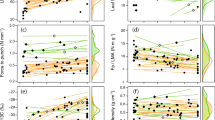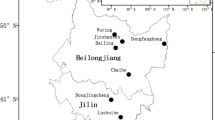Abstract
Plants’ performances are to some degrees dependent on functional traits. Analysis on trait variation that occurs at different levels (or scales) could be an indispensable step towards understanding community assembly and plants’ strategy. Six functional traits were measured in three tropical cloud forests in Hainan Island, China, including leaf area, leaf mass per area, leaf chlorophyll content, leaf thickness, leaf dry weight, and wood density. Trait variations at different organizational scales and taxonomic levels were examined and distinguished by using generalized linear model. From the perspective of organizational scale, we found that trait variations at the interspecific and intraspecific levels were generally stronger than those at the individual or community level; in particular, the interspecific variations of leaf area, leaf mass per area, and leaf dry weight were considerable and accounted for more than half of the total variations. From the taxonomic point of view, we found that plant functional traits generally had stronger variations at species-level than at family- or genus-level, especially in Bawangling. However, variation of woody density was an exception for these tendencies. Our findings demonstrate the multiple sources of trait variations in tropical cloud forests, suggesting that trait-based studies on these forests should not only perform at the species level but also pay attention on the individual-level trait variations.
Access this chapter
Tax calculation will be finalised at checkout
Purchases are for personal use only
Similar content being viewed by others
References
Ackerly DD (2003) Community assembly, niche conservatism, and adaptive evolution in changing environments. Int J Plant Sci 164(S3):S165–S184
Ackerly DD (2004) Adaptation, niche conservatism, and convergence: comparative studies of leaf evolution in the California chaparral. Am Nat 163(5):654–671
Ackerly DD, Cornwell WK (2007) A trait-based approach to community assembly: partitioning of species trait values into within-and among-community components. Ecol Lett 10(2):135–145
Aiba M, Takafumi H, Hiura T (2012) Interspecific differences in determinants of plant species distribution and the relationships with functional traits. J Ecol 100(4):950–957
Albert CH, Thuiller W, Yoccoz NG, Douzet R, Aubert S, Lavorel S (2010) A multi-trait approach reveals the structure and the relative importance of intra- vs. interspecific variability in plant traits. Funct Ecol 24(6):1192–1201
Albert CH, Grassein F, Schurr FM, Vieilledent G, Violle C (2011) When and how should intraspecific variability be considered in trait-based plant ecology? Perspect Plant Ecol Evol Systemat 13(3):217–225
Bolnick DI, Amarasekare P, Araújo MS, Bürger R, Levine JM, Novak M, Rudolf VHW, Schreiber SJ, Urban MC, Vasseur DA (2011) Why intraspecific trait variation matters in community ecology. Trends Ecol Evol 26(4):183–192
Bu W, Zang R, Ding Y (2014) Field observed relationships between biodiversity and ecosystem functioning during secondary succession in a tropical lowland rainforest. Acta Oecol 55(2):1–7
Bubb P, May I, Miles L, Sayer J (2004) Cloud forest Agenda. UNEP-WCMC, Cambridge, UK
Cao K, Rao MD, Yu JP, Liu XJ, Mi XC, Chen JH (2013) The phylogenetic signal of functional traits and their effects on community structure in an evergreen broad-leaved forest. Biodivers Sci 21(5):564–571
Cavender-Bares J, Keen A, Miles B (2006) Phylogenetic structure of Floridian plant communities depends on taxonomic and spatial scale. Ecology 87(sp7):S109–S122
Chave J, Coomes D, Jansen S, Lewis SL, Zanne AE (2009) Towards a worldwide wood economics, spectrum. Ecol Lett 12(4):351–366
Cornelissen JHC, Lavorel S, Garnier E, Díaz S, Buchmann N, Gurvich DE, Reich PB, ter Steege H, Morgan HD, van der Heijden MGA, Pausas JG, Poorter H (2003) A handbook of protocols for standardized and easy measurement of plant functional traits worldwide. Aust J Bot 51(4):335–380
Givnish TJ (1987) Comparative studies of leaf form: assessing the relative roles of selective pressures and phylogenetic constraints. New Phytol 106(s1):131–160
Grady KC, Laughlin DC, Ferrier SM, Kolb TE, Hart SC, Allan GJ, Whitham TG (2013) Conservative leaf economic traits correlate with fast growth of genotypes of a foundation riparian species near the thermal maximum extent of its geographic range. Funct Ecol 27(2):428–438
Hughes AR, Inouye BD, Johnson MTJ, Underwood N, Vellend M (2008) Ecological consequences of genetic diversity. Ecol Lett 11(6):609–623
Jung V, Violle C, Mondy C, Hoffmann L, Muller S (2010) Intraspecific variability and trait-based community assembly. J Ecol 98(5):1134–1140
Lavorel S, Garnier E (2002) Predicting changes in community composition and ecosystem functioning from plant traits: revisiting the holy grail. Funct Ecol 16(5):545–556
Lebrija-Trejos E, Pérez-García, Eduardo A, Meave JA, Bongers F, Poorter L (2010) Functional traits and environmental filtering drive community assembly in a species-rich tropical system. Ecology 91(2):386–398
Long WX, Ding Y, Zang RG, Yang M, Chen SW (2011a) Environmental characteristics of tropical cloud forests in the rainy season in Bawangling National Nature Reserve on Hainan island, South China. Chin J Plant Ecol 35(2):137–146
Long WX, Zang RG, Ding Y (2011b) Air temperature and soil phosphorus availability correlate with trait differences between two types of tropical cloud forests. Flora Morphol Distribut Funct Ecol Plants 206(10):896–903
Long WX, Schamp BS, Zang RG, Ding Y, Huang YF, **ang YZ (2015) Community assembly in a tropical cloud forest related to specific leaf area and maximum species height. J Veg Sci 26(3):513–523
McGill BJ (2008) Exploring predictions of abundance from body mass using hierarchical comparative approaches. Am Nat 172(1):88–101
McGill BJ, Enquist BJ, Weiher E, Westoby M (2006) Rebuilding community ecology from functional traits. Trends Ecol Evolut 21(4):178–185
Meng TT, Ni J, Wang GH (2007) Plant functional traits, environments and ecosystem functioning. Chin J Plant Ecol 31(1):150–165
Messier J, McGill BJ, Lechowicz MJ (2010) How do traits vary across ecological scales? A case for trait-based ecology. Ecol Lett 13(7):838–848
Niinemets Ü (2001) Global-scale climatic controls of leaf dry mass per area, density, and thickness in trees and shrubs. Ecology 82(2):453–469
Paine CET, Baraloto C, Chave J, Hérault B (2011) Functional traits of individual trees reveal ecological constraints on community assembly in tropical rain forests. Oikos 120(5):720–727
Pérez-Harguindeguy N, Díaz S, Garnier E, Lavorel S, Poorter H (2013) New handbook for standardised measurement of plant functional traits worldwide. Austr J Bot 61(3):167–234
Pigliucci M (2001) Phenotypic plasticity: beyond nature and nurture. JHU Press, p 328
Reich PB (2014) The world-wide ‘fast-slow’ plant economics spectrum: a trait manifesto. J Ecol 102:275–301
Shi JP (2007) Community Ecology and biogeographical studies of the Yunnan mountaintop mossy dwarf forest community, Yunnan, China, Graduate School of Chinese Academy of Sciences
Siefert A, Violle C, Chalmandrier L, Albert CH, Taudiere A, Fajardo A, Aarssen LW, Baraloto C, Carlucci MB, Cianciaruso MV, Dantas VD, DeBello F, Duarte LDS, Fonseca CR, Freschet GT, Gaucherand S, Gross N, Hikosaka K, Jackson B, Jung V, Kamiyama C, Katabuchui M, Kembel SW, Kichenin E, Kraft NJB, Lagerstrom A, Le Bagousse-**uer Y, Li YZ, Mason N, Messier J, Nakashizuka T, McC Overton J, Peltzer DA, Pérez-Ramos IM, Pillar VD, Prentice HC, Richardson S, Sasaki T, Schamp BS, Schöb C, Shipley B, Sundqvist M, Sykes MT, Vandewalle M, Wardle DA (2015) A global meta-analysis of the relative extent of intraspecific trait variation in plant communities. Ecol Lett 18(12):1406–1419
Suding KN, Goldstein LJ (2008) Testing the Holy Grail framework: using functional traits to predict ecosystem change. New Phytol 180(3):559–562
Swenson NG, Weiser MD (2010) Plant geography upon the basis of functional traits: an example from eastern North American trees. Ecology 91(8):2234–2241
Vasseur F, Violle C, Enquist BJ, Granier C, Vile D (2012) A common genetic basis to the origin of the leaf economics spectrum and metabolic scaling allometry. Ecol Lett 15(10):1149–1157
Westoby M, Wright IJ (2006) Land-plant ecology on the basis of functional traits. Trends Ecol Evolut 21(5):261–268
Williams-Linera G (2002) Tree species richness complementarity, disturbance and fragmentation in a Mexican tropical montane cloud forest. Biodivers Conserv 11(10):1825–1843
Wright IJ, Reich PB, Westoby M, Ackerly DD, Baruch Z, Bongers F, Cavender-Bares J, Chapin T, Cornelissen JHC, Diemer M, Flexas J, Garnier E, Groom PK, Gulias J, Hikosaka K, Lamont BB, Lee T, Lee W, Lusk C, Midgley JJ, Navas ML, Niinemets Ü, Oleksyn J, Osada N, Poorter H, Poot P, Prior L, Pyankov VI, Roumet C, Thomas SC, Tjoelker MG, Veneklaas EJ, Villar R (2004) The worldwide leaf economics spectrum. Nature 428(6985):821–827
Wright IJ, Falster DS, Pickup M, Westoby M (2006) Cross-species patterns in the coordination between leaf and stem traits, and their implications for plant hydraulics. Physiol Plant 127(3):445–456
Zhang L, Wen ZM, Miao LP (2013) Source of variation of plant functional traits in the Yanhe River watershed:the influence of environment and phylogenetic background. Acta Ecol Sin 33(20):6543–6552
Author information
Authors and Affiliations
Corresponding author
Editor information
Editors and Affiliations
Rights and permissions
Copyright information
© 2022 Springer Nature Singapore Pte Ltd.
About this chapter
Cite this chapter
Kang, Y., Long, W., Wang, X., Feng, G., Yang, Q. (2022). Functional Trait Variation on Community Organization Scale and Systematic Classification Level of Tropical Cloud Forests on Hainan Island, China. In: Long, W. (eds) Tropical Cloud Forest Ecology in Hainan Island. Springer, Singapore. https://doi.org/10.1007/978-981-19-3655-5_4
Download citation
DOI: https://doi.org/10.1007/978-981-19-3655-5_4
Published:
Publisher Name: Springer, Singapore
Print ISBN: 978-981-19-3654-8
Online ISBN: 978-981-19-3655-5
eBook Packages: Biomedical and Life SciencesBiomedical and Life Sciences (R0)




